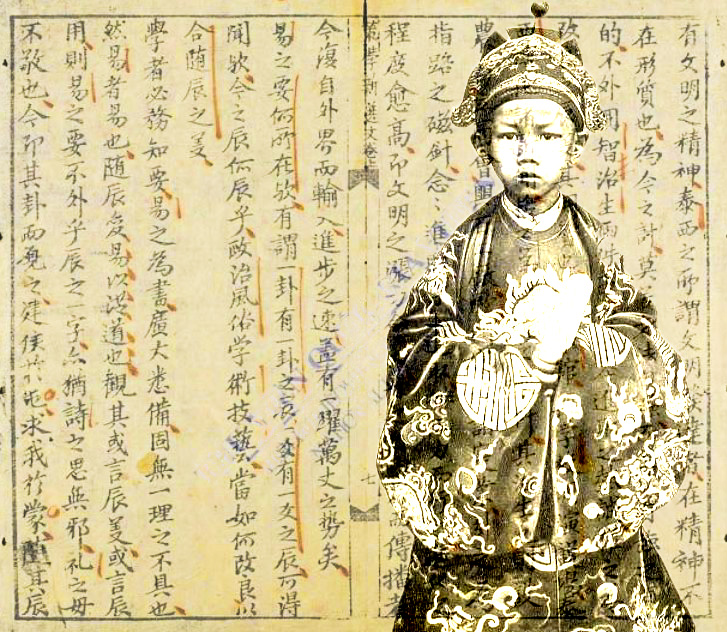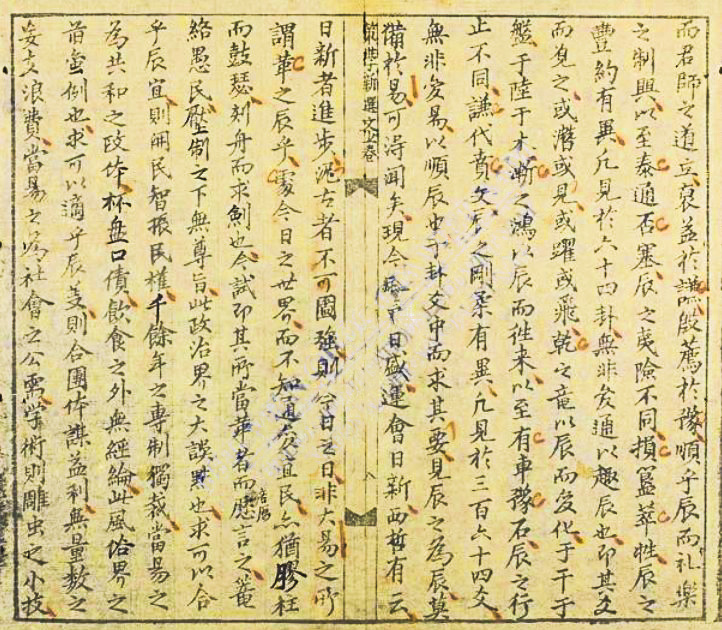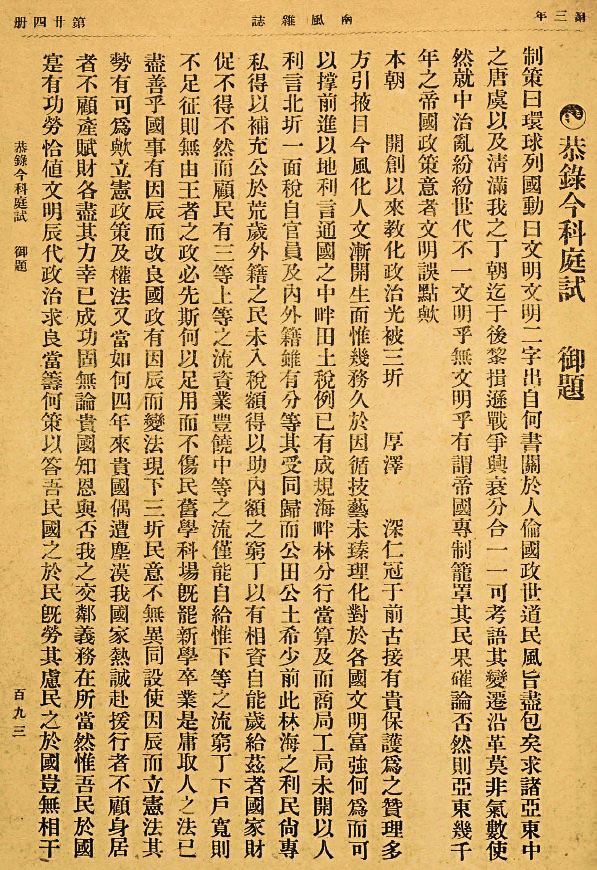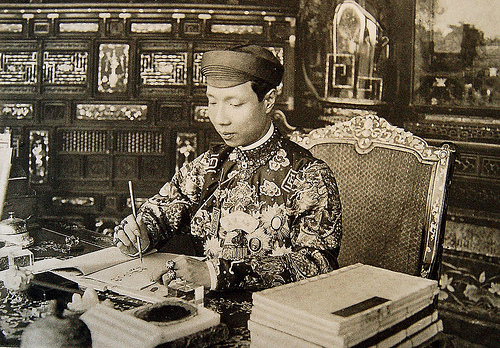In the previous post I introduced a book that Nguyễn Dynasty official and reformist scholar Phạm Quang Sán published in 1909 that sought to introduce students studying for the civil service exams to new ideas.
While many of the questions and answers in that book covered topics that were very new, there were also some questions and answers in that work that as least ostensibly sought to follow traditional ideas and patterns.
The civil service exams at that time contained questions that were based on the (Confucian) classics, and the Classic of Changes (Yijing) was usually tested first. In a previous post I discussed the question concerning the Classic of Changes in the 1910 palace exam, and the model answer that was published for that question that same year.
That question and answer were extremely conservative, as they rejected both Western knowledge and the ideas of reformist scholars in Asia like Liang Qichao, and claimed instead that all knowledge in the world could ultimately be found in the Classic of Changes (or could be created from the Classic of Changes).

In his 1909 A New Selection of Policy Studies (Sách học tân tuyển 策學新選), Phạm Quang Sán included a question about the Classic of Changes that went as follows:
易之要何所在歟。有謂一卦有一卦之時,一爻有一爻之時,何得聞歟。今之時何時乎。歐治風俗,學術技藝,當如何改良以合隨時之義。
“What is the essence of the Changes? Some say that each trigram has its time, and each line has its time. How can this be known? What time is the current time? With European administrative customs and scholarly arts, how should reform be carried out so as to accord with the idea of keeping with the times?”
In answering his own question Phạm Quang Sán cited a line by Song Dynasty Neo-Confucian scholar Cheng Yi that “the Changes is change, change that is in keeping with the times and that follows the Way.” (易,變易也,隨時變易以從道也。)
And what kind of changes did Phạm Quang Sán believe were in keeping with the times of his day? Among others, he felt that “more than a thousand years of despotic rule should be changed to a republican form of government.” (千餘年之專制獨裁,當易之為共和之政體。)

Again, while this question ostensibly followed a “traditional” pattern by asking about ideas in the Classic of Changes, it ultimately moved in a radically new direction.
Perhaps this is why the 1910 exam was so conservative. The period from 1907-1909 was a tumultuous one in Vietnam, as reformers sought to introduce new ideas and new forms of education, and as peasants protested against harsh taxation.
We usually think of the French as the people who would have wanted to suppress these trends, but the 1910 palace exam suggests that at least some individuals among the Nguyễn Dynasty elite also sought to hold back change.
Ultimately, however they were all unsuccessful, because when the final civil service exam was held in 1919, Emperor Khải Định asked about the very same issues that reformist scholar and Nguyễn Dynasty official Phạm Quang Sán had brought up a decade earlier.
However, Emperor Khải Định did this without making any reference to the Classic of Changes or any other (Confucian) classic. Somehow by 1919, even to the emperor of the Nguyễn Dynasty, the (Confucian) classics had become irrelevant.

Here is how Emperor Khải Định’s question began:
制策曰,環球列國動曰文明。文明二字出自何書。關於人倫國政世道民風旨盡包矣。求諸亞東,中之唐虞以及清滿,我之丁朝迄于後黎,揖遜戰爭興衰分合一一可考。語其變遷沿革,莫非氣數使然。究中治亂紛紛世代不一文明乎。有謂帝國專制籠罩其民,果磪輪否。然則亞東幾千年之帝國政策意者文明誤點歟。
“The various countries around the globe are always talking about civilization. What book does this term, “civilization,” come from? Its meaning covers everything from [the proper] human relations, to national administration, to the morals of an age, to people’s customs.
“In looking at the Orient, in China [from the age of] Tang [Yao] and Yu [Shun] up to [the time of] the Manchu Qing, and from our Đinh Dynasty up to the Later Lê, every abdication, war, rise and fall, division and unification can be investigated. With regards to changes and developments over time, all of this is nothing more than the work of destiny.
“[However] in examining the controlling of disorder in China over so many ages, is that not a single civilization? When people say that imperial absolutism casts a shadow over the people, is that just a false claim? And does this mean that thousands of years of imperial policies in the Orient were out of time with civilization?”

In this question (and the question is actually much longer than this – this is just the opening passage), Emperor Khải Định pondered about the long history of absolute rule in Asia, and as a (theoretically) absolute monarch, he was wondering if/how such an institution could continue to exist in an age of “civilization.” What is more, he goes on later in his question to ask whether it would be appropriate to establish a constitution.
A decade after Phạm Quang Sán first made a bold attempt to raise such issues, the emperor of the Nguyễn Dynasty embraced the same ideas.
As such, if we look at 1) Phạm Quang Sán’s radical effort in 1909 to transform the ideas of the people taking the civil service exams, 2) the extremely conservative exam questions and answers in 1910, and 3) Emperor Khải Định’s completely “modern” question in 1919, I think it becomes obvious that a major transformation took place between 1909 and 1919 among the “traditional” elite of Vietnam.
The people at the conservative heart of Vietnam modernized. And they did this themselves, without the aid of revolutionaries or French schools.
Why hasn’t this story ever been told before?

This Post Has 7 Comments
May I ask why the second picture shows Duy Tân in front of some text and what text is that?
It’s the page from A New Selection of Policy Studies (Sách học tân tuyển 策學新選) that contains the question that is translated under the image. And Duy Tân is there because this text was published during the years of his rule.
Who are the three people in the first image? Thanks.
I have no idea. I just found that image on the Internet. 🙂
Actually, I just found the source for this image, and it says that these are three officials awaiting the arrival of Emperor Khai Dinh in Marseille in 1922.
http://gallica.bnf.fr/ark:/12148/btv1b530824232.r=khai%20dinh?rk=600861;2
The orthodox narrative that the literati and mandarins were opposed to innovation is probably accurate . As the infamous collaborationist mandarin Hoàng Cao Khải 黃高啟 reported in his history book Nam sử kinh :[ in the 28th year of Tự Đức (嗣德) reign , in the civil examinations was asked for commentary on the subject : « should we follow the road taken by the Japanese ? The answer : Japan formerly followed the ways of the Chinese . Now they are imitating the western techniques and jetttisoning the teachings of the Sages . Even though they get prosperous and strong , they will become savages ]. Hoàng Cao Khải of course was of the opinion that his fellows were hard -headed conservatives .
An explanation of this attitude . The Chinese and Vietnamese were keen on staying lands of civilization ( văn hiến chi bang ) and therefore their insistence on the studying of the Classical Books ; because only thanks to that , would they keep a high level of moral values ( according to Paul Mus , as the Americans today , they had an exceptionalist mindset ; they thought of their country as civilized and themselves as « human beings « and considered the other people as non-humans , thus the westerners were called bạch quỷ , this should not be construed as name calling but as a classification ) The conservatives knew that if they imitate more or less the western ways , they willy nilly would be transformed by the techniques and lose their « human-ness« .
With the benefit of hindsight , one can say that the conservatives had a point :the Japanese went on a murderous rampage , their reputation is muddied for centuries .
Yes, I think this is true, but what I think the materials I wrote about recently show is that there was a serious debate within the conservative world of the Nguyen Dynasty, and that ultimately the group that wanted to reform succeeded. That is something which I don’t think most historians recognize. Everyone knows that there was resistance to reform, but people don’t realize that there were people in the Nguyen Dynasty world who were pro-reform.